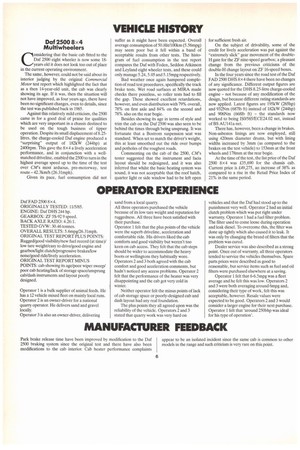VEHICLE HISTORY
Page 114

If you've noticed an error in this article please click here to report it so we can fix it.
Daf 2500 8x4 Multiwheelers considering that the basic cab fitted to the Daf 2500 eight wheeler is now some 18years old it does not look too out of place in the current operating environment.
The same, however, could not be said about its interior judging by the original Commercial Motor test report which highlighted the fact that as a then 14-year-old unit, the cab was clearly showing its age. If it was, then the situation will not have improved, as four years ago, there have been no significant changes, even to details, since the test was published back in 1985.
Against this relatively mild criticism, the 2500 came in for a good deal of praise for qualities which are very important in a chassis destined to be used on the tough business of tipper operation. Despite its small displacement of 8,25litres, the charge-cooled Daf engine produced a "surprising" output of 182kW (244hp) at 2400rpm. This gave the 8x4 a lively acceleration performance, and in conjunction with a wellmatched driveline, enabled the 2500 to turn in the highest average speed up to the time of the test over CM's most arduous, pre-motorway, test route — 42.3km/h (26.31mph).
Given its pace, fuel consumption did not suffer as it might have been expected. Overall average consumption of 50.81it/100km (5.56mpg) may seem poor but it fell within a band of acceptable results from other tests. The histogram of fuel consumption in the test report compares the Daf with Foden, Seddon Atkinson and Leyland eight wheeler tests, and these could only manage 5.24,5.05 and 5.15mpg respectively.
Bad weather once again hampered completion of road test procedures, specifically the track brake tests. Wet road surfaces at MIRA made checks there pointless, so roller tests had to fill the gap. These showed excellent retardations, however, and even distribution with 79% overall, 78% on first axle and 84% on the second and 78% also on the rear bogie.
Besides showing its age in terms of style and trim the cab on the Daf 2500 was also seen to be behind the times through being unsprung. It was fortunate that a Bostrom suspension seat was standard. When set to match the driver's weight, this at least smoothed out the ride over bumps and potholes of the roughest roads.
Commenting on the cab of the 2500, CM's tester suggested that the instrument and facia layout should be redesigned, and it was also inferred that whilst the basic heating system was sound, it was not acceptable that the roof hatch, quarter light or side window had to be left open
for sufficient fresh air.
On the subject of drivability, some of the credit for lively acceleration was put against the "extremely slick" gear movement of the doubleH gate for the ZF nine-speed gearbox; a pleasant change from the previous criticisms of the double-H change layout on ZF 16-speed boxes.
In the four years since the road test of the Daf FAD 2500 DHS 8x4 there have been no changes of any significance. Different output figures are now quoted for the DHS 8.25-litre charge-cooled engine — not because of any modification of the design, but because different rating standards are now applied. Latest figures are 195kW (265hp) and 932Nm (6871b ft) instead of 182kW (244hp) and 906Nm (668Ib ft) — the standards now worked to being IS0/585/ECE24.02 net, instead of BS AU141a net.
There has, however, been a change in brakes. Non-asbestos linings are now employed, still using 420mm diameter drums, but with lining widths increased by 3nun (as compared to the brakes on the test vehicle) to 153mm at the front wheels and 178mm at the rear bogie.
At the time of the test, the list price of the Daf 2500 8x4 was £35,690 for the chassis cab. Current price is £49,275, an increase of 38% as compared to a rise in the Retail Price Index of 21% in the same period.












































































































































